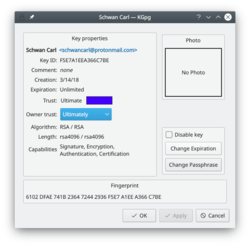KGpg
KGpg bietet eine grafische Schnittstelle zu gpg-Befehlen
GnuPG verschlüsselt und entschlüsselt Ihre E-Mail und ausgewählte Dateien. Dazu gibt es sehr viele Kommandozeilen-Optionen. KGpg vereinfacht dies - Sie müssen sich keine Befehle merken. KGpg kann Ihnen dabei helfen, Ihre Schlüssel einzurichten und zu verwalten, Schlüssel zu im- und exportieren sowie Schlüssel-Signaturen, den Vertrauens-Status und das Ablaufdatum anzuzeigen. Alles, was Sie hierzu brauchen wird von KGpg erledigt. Außerdem steht ein Assistent zur Verfügung, um Ihnen beim Einrichten Ihrer Schlüssel zu helfen.
KGpg ist in Konqueror und Dolphin integriert, wo Sie Dateien über ein Kontext-Menü verschlüsseln können, mit oder ohne Signatur.
 |
[[Image:Kgpg-options.png | thumb | 250px | Rechtsklick auf einen Schlüssel, um die Optionen anzuzeigen.] ] |
Die Gültigkeitsdauer eines Schlüssels verändern
Wie in der obigen Abbildung zu sehen ist kann man die Gültigkeitsdauer eines Schlüssels mit der Schaltfläche bearbeiten. Dazu wählt man einfach das gewünschte neue Ablaufdatum in dem angezeigten Kalender. Diese Möglichkeit besteht jedoch nur wenn man Zugang zum privaten Schlüssel und dem passenden Kennsatz hat. Fehlt eines kann man keine Änderungen vornehmen.
Kennsatz ändern
Spätestens wenn man vermutet das jemand anders in den Besitz des Kennsatzes gelangt ist sollte man ihn im Dialog Schlüsseleigenschaften ändern. Die Schaltfläche befindet sich direkt unter der Schaltfläche .
Revoking a key
If you lose your private key or think it has been compromised in some way you need to revoke it. To reliably render a key unusable you need to revoke it. Revoking is done by adding a special revocation signature to the key.
The revocation signature can be created together with the key. In this case it is stored in a separate file. This file can later be imported into the keyring and is then attached to the key rendering it unusable.
If you have not created such a detached revocation on key creation you can
create such a revocation signature at any time choosing , optionally importing it to your keyring immediately.
Eine vollständige bebilderte Anleitung hilft Ihnen bei allen Fragen.
Wenn Sie sich nicht in der Lage sind, die Identität Ihrer Kontakte physisch zu überprüfen, sollten Sie vor allem Schlüssel-Signatur lesen, wo die Vorteile der lokalen Signatur erklärt werden.
Useful external resources
Kategorie: Sicherheit



